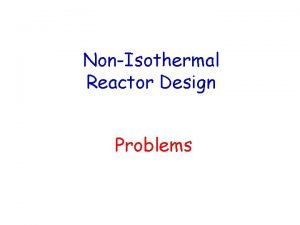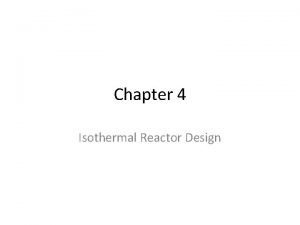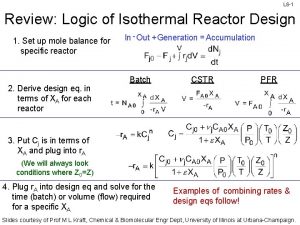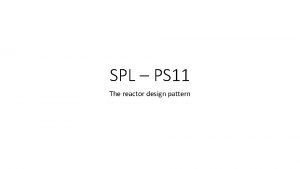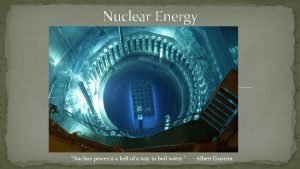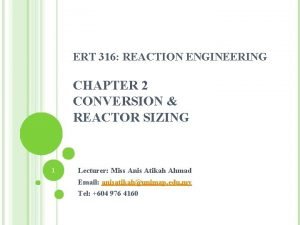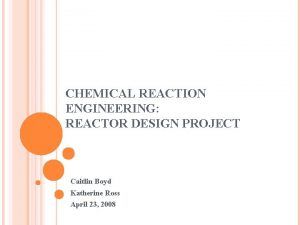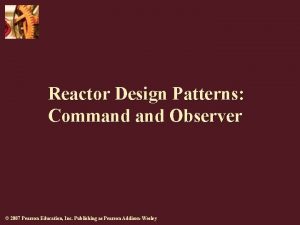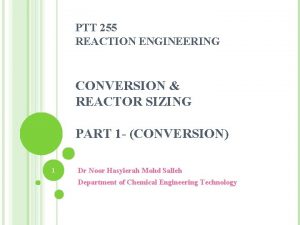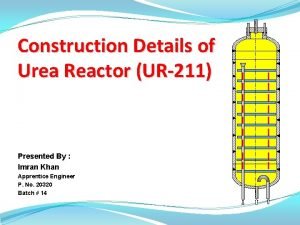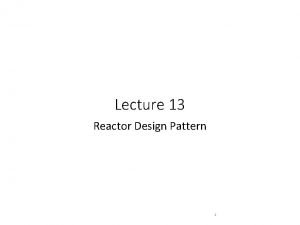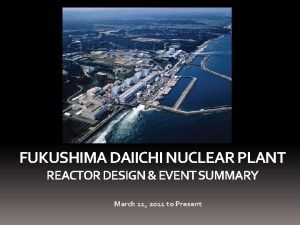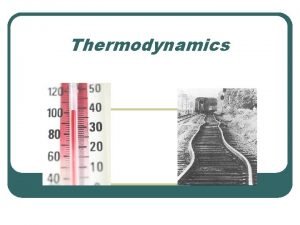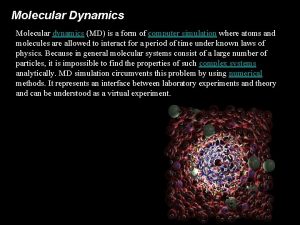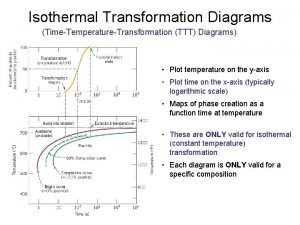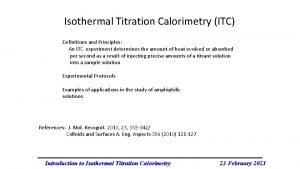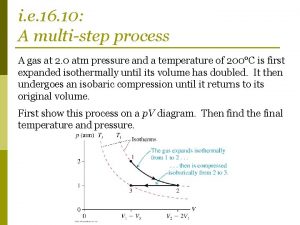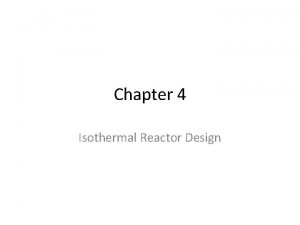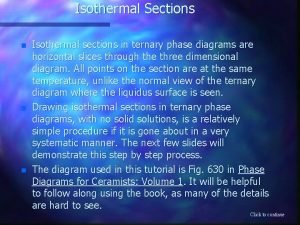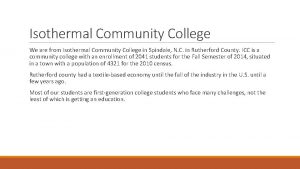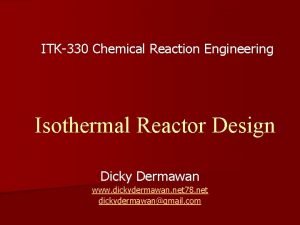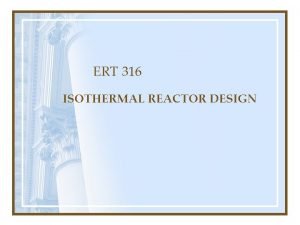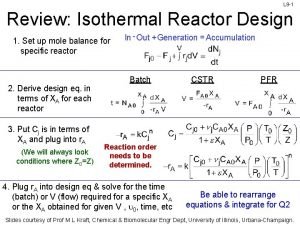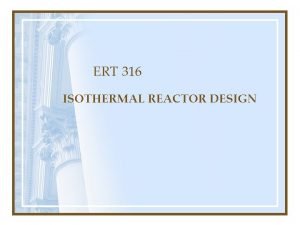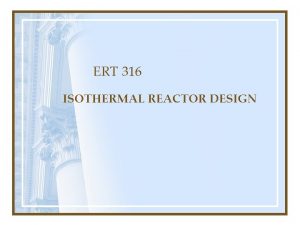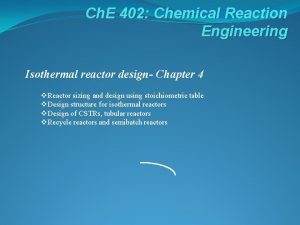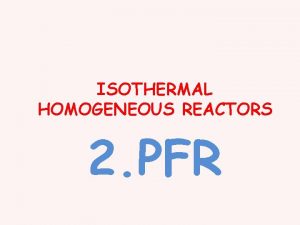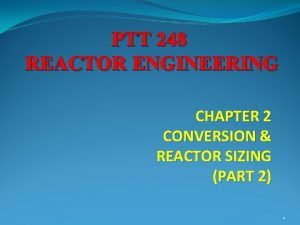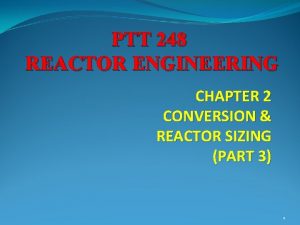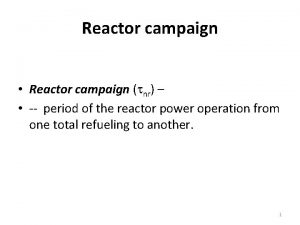Chapter 4 Isothermal Reactor Design Overview Chapter 1
















- Slides: 16

Chapter 4 Isothermal Reactor Design

Overview • Chapter 1 and 2 focus on mole balances on reactors to predict the volume • Chapter 3 focuses on reactions • Cahpter 4 combine previous chapters to obtain optimum reactor design

Design Algorithm 1. Mole balance (reactor type) 2. Reaction rate law (reaction type, orders) 3. Stoichiometry (reaction coefficients) 4. Combine steps 1, 2 and 3 5. Evaluate (integrate) either Analytically Graphically Numerically Polymath


Liquid Phase Batch For the irrev, 2 nd order reaction • Mole balance step • Rate law step • Stoichiometry step • Combine step • Evaluate step

4. 3 CSTR For 1 st order and irrev reaction • Mole balance step • Rate law step • Stoichiometry step • Combine step • Evaluate step • Damkohler number Da • Da gives the degree of conversion in flow reactor

4. 3. 2 CSTRs in Series • For equal size CSTRs τ1=τ2=τ operate at the same T k 1=k 2=k and constant ν 0 • For n equal size CSTRs τ1=τ2=…=τn=τ operate at the same T k 1=k 2=…=kn=k

4. 3. 3 CSTRs in Parallel • For identical individual reactor volume, Vi, conversion, Xi, and reaction rate -r. Ai • The conversion by each reactor is the same as if the total feed is charged to one large reactor of volume V

4. 3. 4 2 nd order reaction in a CSTR • For 2 nd order, liquid phase reaction in a CSTR

4. 4 Tubular Reactors • Consider 2 nd order reaction in PFR For liquid phase For constant T and P gas phase

• Three reaction types A→n. B – n<1, ε<0 (δ<0) → ν↓, the molecules will spend longer time and ↑X than if v=v 0 – n>1, ε>0 (δ>0) ν ↑, the molecules will spend less time and ↓ X than if v=v 0 – n=1, ε=0 (δ=0) v=v 0

4. 5 Pressure Drop in Reactors • For liquid phase reactions the pressure drop can be ignored because the effect of pressure on the concs is small. • For gas phase reactions the conc. of the reacting species is directly proportional to the total pressure • Accounting for the pressure drop is a key factor in the proper reactor operation

4. 5. 1 Pressure drop and the rate law • To account for pressure drop differential form design equation must be used • For gas phase 2 nd order reaction in PBR

4. 5. 2 Flow through a packed beds • If y is defined as y=P/P 0 • For a gas phase reactions in PBR of catalyst particles • α is the bed characteristics

4. 5. 4 Analytical solution • For 2 nd order isothermal reaction with ε=0 in PBR

Integrating with X=0 @ W=0 and Solving for X and W gives
 Non isothermal reactor design problems
Non isothermal reactor design problems Isothermal
Isothermal Isothermal reactor design
Isothermal reactor design Reactor design pattern
Reactor design pattern Rbmk reactor design flaws
Rbmk reactor design flaws Space time of reactor
Space time of reactor Reactor design project
Reactor design project Reactor pattern
Reactor pattern Design equation
Design equation Urea reactor design
Urea reactor design Reactor pattern java
Reactor pattern java Fukushima reactor design
Fukushima reactor design Isothermal expansion of ideal gas
Isothermal expansion of ideal gas Isobaric isothermal ensemble
Isobaric isothermal ensemble Ttt diagram for eutectoid steel
Ttt diagram for eutectoid steel Isothermal titration calorimetry principle
Isothermal titration calorimetry principle Work done by isothermal process
Work done by isothermal process
